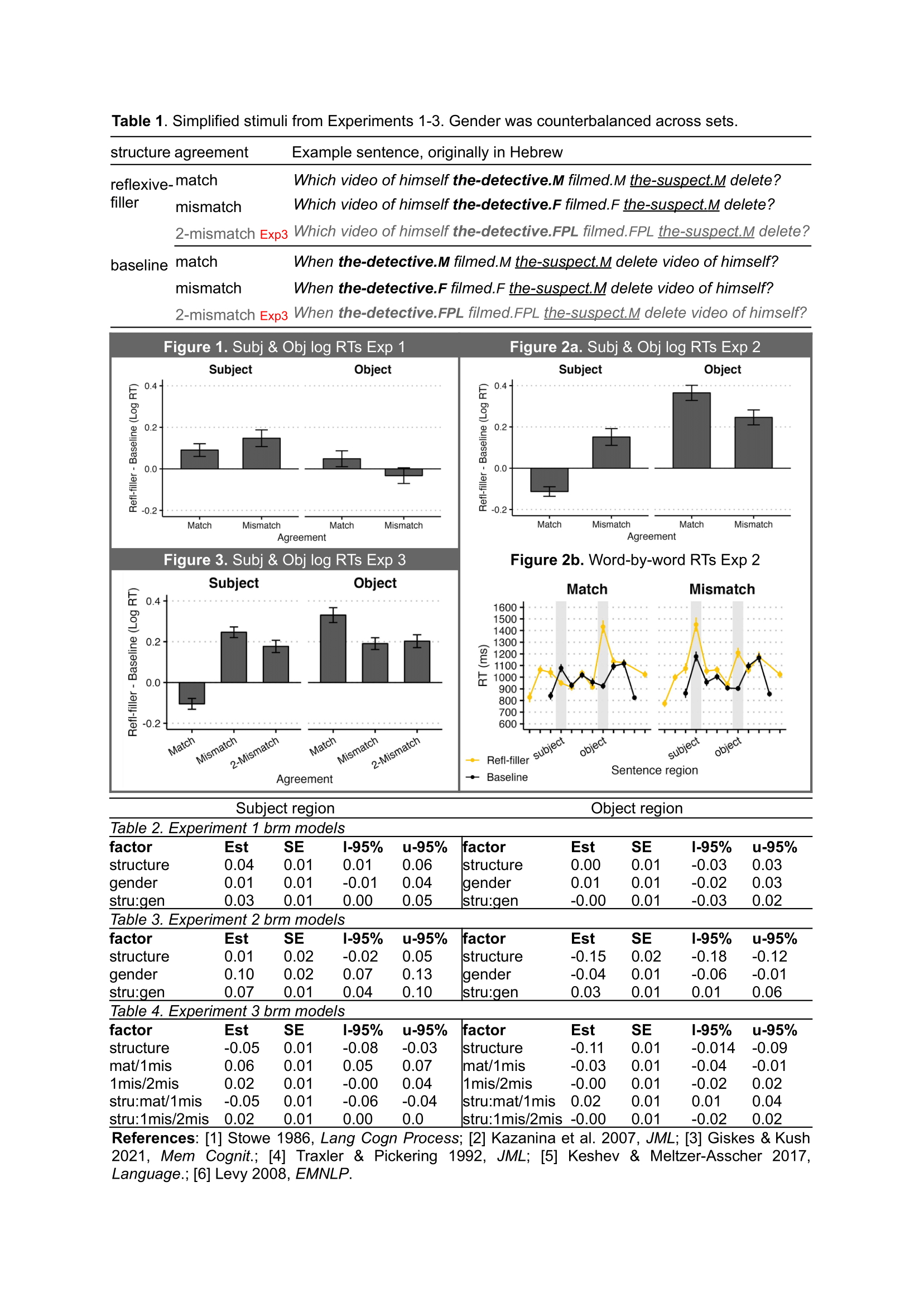הרצאה של מנדי קרטנר (שיתוף פעולה עם פרופ' איה מלצר-אשר)
ב-HSP
עבודה משותפת של מנדי קרטנר ופרופ' איה מלצר-אשר:
Gap predictions is not fully constrained by grammar: Hebrew Maze results
(ניתנה בכנס השנתי ה-38 לעיבוד משפטים באוניברסיטת מרילנד)
:תקציר
Dependency resolution is a predictive process. In filler-gap dependencies, a filler triggers an active search for its gap, reflected in the filled-gap effect (FGE): increased difficulty when a potential gap position is filled [1]. Likewise, in cataphoric dependencies, a cataphor triggers an active search for an antecedent, reflected in difficulty when a potential antecedent mismatches the cataphor’s features [2-3]. We investigate readers’ online predictions when these two searches are triggered simultaneously, in sentences headed by a “reflexive-filler”, e.g., “Which picture of herself”. Grammatically, the two searches triggered by the reflexive-filler are not independent: the antecedent must be hierarchically higher than the gap, and bind the reflexive in its base position. We investigate whether this grammatical constraint informs online predictions, focusing on filled-gap (FG) sentences, e.g. (1).
(1) Which picture of herself did the {queen | king} see the girl admiring _?
When the matrix subject matches the reflexive’s features (‘queen’), a gap would be grammatical in the FG position (object of ‘see’); when they mismatch (‘king’), it would not. Does this grammatical constraint affect gap prediction, modulating the FGE on ‘the girl’? If the parser is grammar-driven, gap prediction should halt until an antecedent is identified, and no FGE should arise after a mismatch (as in Islands [1,4-5]). However, if the parser prioritizes short filler-gap dependencies even when illicit, the FGE should remain.
We report one SPR and two Maze experiments on Hebrew. For each experiment, one brm model was fit to subject RTs, and a separate model was fit to object (FG) RTs.
Exp 1. 60 participants read (via SPR) 24 item sets, manipulating agreement (Gender match/mismatch between the reflexive and subject) and structure (refl-filler/baseline) (Table 1). Subject: a mismatching subject was read slower than a matching one following a refl-filler, but not in the baseline. Object: no slowdown in refl-filler compared to baseline (no FGE), and no interaction with agreement (Figure 1, Table 2).
Exp 2 is a replication of Exp 1 using the G-Maze task. Subject: Replicating the SPR results, a mismatching subject following a refl-filler caused a slow-down. Object: object RTs were slower in the refl-filler conditions than the baseline (FGE), both in the match condition and, to a lesser extent, in the mismatch condition (Figure 2a-b, Table 3).
Exp 3 manipulated the degree of mismatch between the reflexive and the subject, to test whether illicit gap prediction is the result of rational misinterpretation [6]. 90 participants read (via G-Maze) 36 item sets, crossing: structure (refl-filler/baseline) and agreement (match/mismatch/2-mismatch); in 2-mismatch the subject mismatches the reflexive in Gen+Num (Table 1). Subject: mismatching subjects were read slower in the refl-filler structure compared to baseline. Object: longer RTs in the refl-filler compared to the baseline (FGE). This slow-down was smaller, but still reliable, in the mismatch condition. There was no evidence for a reliable contrast between mismatch and 2-mismatch (Figure 4, Table 4).
Discussion. Across the three studies, we find a reliable slowdown at a mismatching subject following a fronted reflexive, indicating an active antecedent search [cf. 2-3]. In the Maze studies, we find evidence for an object FGE. Exp 1 (SPR) did not produce a FGE, which we hypothesize is a task effect: SPR is rather passive, and may produce inattentive participants. This is supported by lower comprehension accuracy in the SPR (66%) vs Maze (88%).
In the Maze studies, the FGE was modulated by the presence of an antecedent, such that the FGE was smaller following a mismatching subject. This suggests that gap predictionis sensitive to the requirements of the reflexive-filler. However, the FGE persisted in the mismatch condition, which is unpredicted if the parser were grammatically driven: grammatically, no gap should be posited unless an antecedent was identified. Exp 3 was designed to test the hypothesis that a FGE after a mismatch is the result of rationalization over noisy reading [6], i.e., participants misrepresent the reflexive’s features, as a mismatch is unlikely, and only thusly predict a gap. In the 2-Mismatch condition, misrepresentation is less likely, and the FGE should diminish further. This hypothesis was not corroborated, which suggests that the FGE after a mismatch reflects processing pressures overriding grammar, such that gap prediction persists despite ungrammaticality. Interestingly, this is unlike Island structures, which are evidenced to fully block gap prediction [1,4-5].

יישר כח!


